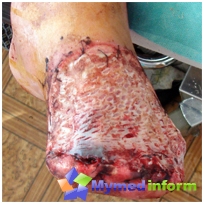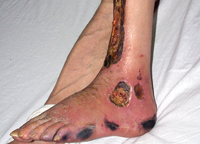What is gas gangrene? Causes of disease development? Diagnosis and treatment of gas gangrene? Answers to the questions you will find in the article.
Content
What is gas gangrene
Gas gangrene - a rare infection caused by anaerobic bacterium that does not need oxygen and enters the body through wounds and during surgical operations. Most often it is found in deep wounds, usually limbs, abdomen, less often uterus.
Gas gangrene develops in the presence of sections of fabric, devoid of blood supply, due to injury or surgical intervention. With adequate treatment of 80% of people with gas gangrea limbs survive. The forecast deteriorates if the disease develops in other places (for example, in the abdominal cavity).
Causes of the development of gangrenes
Anaerobic bacteria are normally present in the intestinal microflora and organs of the urogenital system; They also live in soil. Infection develops due to bacteria from entering wounds during surgical operations and as a result of injuries.
Symptoms of gangrene

Gas gangrene causes inflammation of tissues under the skin. Indicated signs of infection develop in 72H after injury or surgery. A distinctive feature of gas gangrene is attachment (cracking sounds), which is caused by the accumulation of carbon dioxide and hydrogen in dead tissues.
Other typical symptoms: severe pain in the wound, swelling and changing skin painting (often the skin becomes a dark brown or reddish color), blistering can be formed, sections of necrosis, heavy smell, blood clot appear, peniste; Infection spreads.
In addition to local symptoms, signs of sepsis (blood infection) appear early and decrease the volume of body fluids (the increase in heartbeat, respiration, the fall in blood pressure); Temperature usually does not rise above 38.3°. Despite the pallor, emission and immobility, most patients remain in consciousness, well-oriented in the environment and experience the strongest feeling of anxiety.
Usually death comes suddenly, often during a surgical operation to remove dead tissue. Less often, the death develops delirium and coma, sometimes vomiting, profuse diarrhea and cardiovascular failure.
Diagnosis of gangrene
The recently transferred surgical operation or the presence of deep wound brushes, as well as the rapid development of pain and crepitiation around the wound, takes into account the diagnosis. The diagnosis is clarified by research of the wound secret. X-ray can show presence in gas tissues. Blood tests also detect the presence of infection.
Treatment of gangrene
When the first signs of inflammation of tissues under the skin are required to begin treatment immediately. It lies in the surgical removal of all affected tissues. Sendance or deficiency of operational intervention can cost a sick life. In addition, large doses of Penicillin are prescribed. If possible, the oxygen therapy is carried out.









